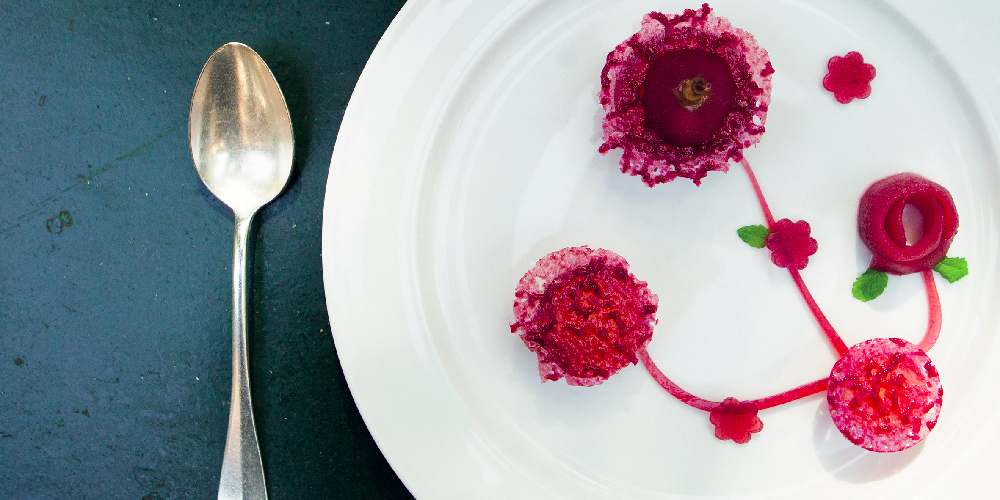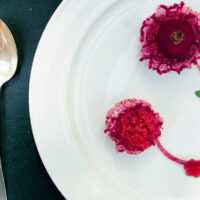
Poires au vin rouge
Indulge in a delightful dessert that captures the essence of Burgundy’s fruits. Chef Stéphanie Moreau’s creation is a modern twist on the traditional recipe of pears stewed in Beaujolais wine.
Related recipes:
Recipe Introduction
Based on the traditional recipe of pears stewed in Beaujolais red wine, chef Stéphanie Moreau creates a dessert that brings together three of Burgundy’s favourite fruits: the pear, the grape and the blackcurrant. From hearty stews to savoury cakes, wine seems to find its way into most recipes that originate in Burgundy, and that doesn’t stop at the dessert trolley. The traditional recipe, poires à la bonne femme, was designed to use up the pears that had not properly ripened and consisted of the fruit being boiled in sugar to disguise its grainy texture before wine was added for colour rather than flavour. During this process, the skin would go wrinkly, supposedly like an ‘old wife’, or ‘bonne femme’, which is how it got its name.
In this aromatic dessert, created by Stéphanie, the pears get a further boost in flavour by being marinated in wine for two days, along with citrus fruit, and cinnamon, which lend it a festive feel. As chef at the bucolic Moulin des Ruats, hidden in woods in the wildly beautiful Parc Naturel Régional du Morvan near Avallon, Stéphanie’s favoured method sees the pears gently infused with the wine, rather than boiling them in it. “It improves the taste of the wine,” she explains. Working at the cosy former watermill, Stéphanie has developed the dish into a sophisticated dessert that leaves its rustic roots firmly in the past. She serves it with a chocolate sorbet or ice cream, a red wine jelly and a tuile wafer that is made with one of Burgundy’s other key ingredients: blackcurrants. “You can use blackcurrant sorbet instead of chocolate to carry through the blackcurrant theme,” says Stéphanie, adding: “The tuile gives the dish an extra crunch, which works with the softness of the pears.”
This extra touch is a nod to the blackcurrants that were traditionally grown alongside the grapes by the wives of Burgundy winegrowers. While the main harvest was, of course, the wine, the blackcurrants were used to create the local liqueur named crème de cassis, which – like the wine –also finds its way into many a dessert in this corner of France.
Recipe Card
Poires au vin rouge
Ingredients
For the pears & red wine jelly
- 10 pears
- 1 L 13/4pt Beaujolais Nouveau red wine
- 1 L 13/4pt water
- Zest & juice of 1 orange
- Zest & juice of 1 lemon
- 1 cinnamon stick
- 6 g 1/4oz agar-agar powder
For the tuile
- 410 g 141/2oz blackcurrant purée
- 35 g 11/4oz flour
- 220 g 73/4oz icing sugar
- 20 g 3/4oz butter
- Chocolate sorbet to serve
- Mint leaves to garnish
Instructions
- Peel the pears (leaving the stalks in place) and place in an airtight container with the red wine, the water, orange juice and its zest, lemon juice and its zest, and cinnamon stick, and leave in the fridge for 48 hours.
- Prepare the tuile by mixing the purée, flour, icing sugar and butter in a food processor.
- Place teaspoons of the tuile mixture onto a sheet of greaseproof paper and spread it out in circles of approx. 5cm (2in) in diameter with your finger. Place in the fridge overnight.
- Take the pears from the fridge and remove them from the red wine, reserving the liquid. Cut the pears in quarters horizontally and core each piece with an apple corer (this indentation will be filled with chocolate sorbet later).
- To make the jelly, put 200ml (7fl oz) of the reserved wine mixture in a pan with the agar-agar and bring to the boil until it starts to thicken.
- Line a large baking sheet with cling film and pour the warm jelly mixture onto it. Spread out to a thickness of about 3mm-5mm (up to 1/4in). Place in the fridge for about 30 minutes.
- Remove the tray of tuiles (from step 3) from the fridge and bake in a preheated oven for 10 minutes at 150°C (300°F). They should appear slightly transparent. While still warm, cut each tuile in a neat circle with a pastry cutter. Leave to cool.
- When ready to serve, fill the centre of each piece of pear with the chocolate sorbet, and arrange the pears on the plate with slices of the jelly and the tuile, and small mint leaves to garnish.
Notes
First printed in our sister publication France Today.
France Today has recently launched their digital membership, bringing you the best of France. As a Member, you can find immersive and interactive travel features where you can embark on a fascinating journey alongside a Parisian Café Owner or a skilled Kouign Amann Baker. But that’s not all – Members are also treated to engaging live events including an upcoming event with food podcaster and Masterchef alumnus, Andrew Prior. Plus, gain access to the extensive library of past events and the digital edition of the France Today magazine, where you can discover tantalising recipes and stay updated on the vibrant culinary scene in France.
Latest posts:
Share to: Facebook Twitter LinkedIn Email
More in Blackcurrants, Chocolate, Fruits, Lemon, Mint, Pears, Purée, Recipe, Seaosnal, Sugar, Traditional







